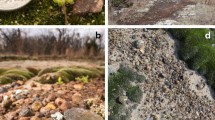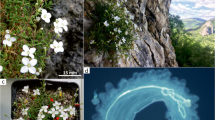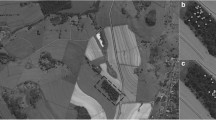Abstract
Polygala lewtonii is a federally endangered, amphicarpic plant with a mixed mating system and three types of flowers: (1) aboveground, chasmogamous flowers (i.e., open-pollinated; CH), (2) aboveground, cleistogamous flowers (i.e., closed, selfing; CL) and (3) CL flowers on belowground stems (amphicarpy). Aboveground seeds are ant-dispersed, whereas belowground seeds are spaced across the length of the rhizome. Here, we collected individuals of P. lewtonii at both range-wide and fine geographic scales and genotyped them at 11 microsatellite loci. We analyzed patterns of genetic diversity and structure to understand: (1) the predominant mating system (selfing or outcrossing), (2) the movement of pollen and seeds across the landscape, and (3) the optimal strategy to conserve the full range of genetic variation. P. lewtonii reproduces predominantly by selfing or bi-parental inbreeding, but reproduction occurred through each of the three flower types. Some individuals produced by selfing/inbreeding were tightly clustered spatially, and were likely produced either by belowground flowers or by aboveground flowers with limited seed dispersal. Other selfed/inbred individuals were spatially separated (maximum of 15 m), and were likely produced by aboveground flowers followed by seed dispersal by ants. Fine-scale patterns of genetic structure indicate that some gene flow is occurring among aboveground CH flowers but both pollen and outcrossed seeds are moving limited distances (maximum of 0.5 km). Because genetic variation is structured at a fine spatial scale, protecting many populations is necessary to fully conserve the genetic variation in P. lewtonii. Conservation seed banking, if accompanied by research on seed germination requirements, may also contribute to the effective protection of genetic variation in P. lewtonii.


Similar content being viewed by others
References
Barker NP (2005) A review and survey of basicarpy, geocarpy, and amphicarpy in the African and Madagascan flora. Ann Mo Bot Gard 92:445–462
Barrett SCH, Shore JS (1987) Variation and evolution of breeding systems in the Turnera ulmifolia L. complex (Turneraceae). Evolution 41:340–354
Baskin C, Baskin J (2014) Seeds: ecology, biogeography, and, evolution of dormancy and germination, 2nd edn. Academic/Elsevier, San Diego
Berg H, Redbo-Torstensson P (1999) Offspring performance in three cleistogamous Viola species. Plant Ecol 145:49–58
Birchler JA, Yao H, Chudalayandi S, Vaimanb D, Veitiac RA (2010) Heterosis. Plant Cell 22:2105–2112
Boutin-Ganache I, Raposo M, Raymond M, Deschepper CF (2001) M-13 tailed primers improve the readability and usability of microsatellite analyses performed with two different allele sizing methods. Biotechniques 31:6–8
Brown AHD (1979) Enzyme polymorphism in plant populations. Theor Popul Biol 15:1–42
Brown AHD, Munday J (1982) Population-genetic structure and optimal sampling of land races of barley from Iran. Genetica 58:85–96
Brunet J, Eckert CG (1998) Effects of floral morphology and display on outcrossing in Blue Columbine, Aquilegia caerulea (Ranunculaceae). Funct Ecol 12:596–606
Busch JW (2005) The evolution of self-compatibiliy in the geographically peripheral populations of Leavenworthia alabamica (Brassicaceae). Am J Bot 92:1503–1512
Charlesworth D, Charlesworth B (1987) Inbreeding depression and its evolutionary consequences. Annu Rev Ecol Syst 18:237–268
Cheplick GP (1987) The ecology of amphicarpic plants. Trends Ecol Evol 2:97–101
Cheplick GP (1994) Life history evolution in amphicarpic plants. Plant Species Biol 9:119–131
Cheplick GP (2005) Biomass partitioning and reproductive allocation in the invasive, cleistogamous grass Microstegium vimineum: influence of the light environment. Torrey Bot Soc 132:214–224
Chybicki IJ, Burczyk J (2009) Simultaneous estimation of null alleles and inbreeding coefficients. J Hered 100:106–113
Clavijo ERDE (1995) The ecological significance of fruit heteromorphism in the amphicarpic speicies Catananche lutea (Asteraceae). Int J Plant Sci 156:824–833
Clay K, Antonovics J (1985) Demographic genetics of the grass Danthonia spicata: success of progeny from chasmogamous and cleistogamous flowers. Evolution 39:205–210
Cole CT, Biesboer DD (1992) Monomorphism, reduced gene flow, and cleistogamy in rare and common species of Lespedeza (Fabaceae). Am J Bot 79:567–575
Cruden RW, Lyon DL (1989) Facultative xenogamy: examination of a mixed mating system. Evol Ecol Plants 171:208
Darwin C (1877) The different forms of flowers on plants of the same species. John Murray, London
Dick CA, Herman JA, O’Dell RE, Lopez-Villalobos A, Eckert C, Whittall JB (2014) Cryptic genetic subdivision in the San Benito evening primrose (Camissonia benitensis). Conserv Genet 15:165–175
Dieringer D, Schlotterer C (2003) Microsatellite analyser (MSA): a platform independent analysis tool for large microsatellite data sets. Mol Ecol Notes 3:167–169
Doyle J, Doyle J (1987) A rapid isolation procedure for small quantities of fresh tissue. Phytochem Bull 19:11–15
Eckert CG (2000) Contributions of autogamy and geitonogamy to self-fertilization in a mass-flowering, clonal plant. Ecology 81:532–542
El Mousadik A, Petit RJ (1996) High level of genetic differentiation for allelic richness among populations of the argan tree [Argania spinosa (L.) Skeels] endemic to Morocco. Theor Appl Genet 92:832–839
Ersts PJ (2015) Geographic distance matrix generator (version 1.2.3)
Excoffier L, Smouse PE, Quattro JM (1992) Analysis of molecular variance inferred from metric distances among DNA haplotypes: application to human mitochondrial DNA restriction data. Genetics 131:479–491
Excoffier L, Laval G, Schneider S (2005) Arlequin (version 3.0): an integrated software package for population genetics data analysis. Evol Bioinform Online 1:47–50
Faircloth BC (2008) MSATCOMMANDER: detection of microsatellite repeat arrays and automated, locus-specific primer design. Mol Ecol Resour 8:92–94
Furches MS, Wallace LE, Helenurm K (2009) High genetic divergence characterizes populations of the endemic plant Lithophragma maximum (Saxifragaceae) on San Clemente Island. Conserv Genet 10:115–126
Gao H, Williamson S, Bustamante CD (2007) A Markov chain Monte Carlo approach for joint inference of population structure and inbreeding rates from multilocus genotype data. Genetics 176:1635–1651
Gao H, Bryc K, Bustamante CD (2011) On identifying the optimal number of population clusters via the deviance information criterion. Plos One 6:e21014
Gilbert KJ, Andrew RL, Bock DG, Franklin MT, Kane NC, Moore JS, Moyers BT, Renaut S, Rennison DJ, Veen T, Vines TH (2012) Recommendations for utilizing and reporting population genetic analyses: the reproducibility of genetic clustering using the program structure. Mol Ecol 21:4925–4930
Goudet J (2002) FSTAT (version 2.9.3.2) a computer program to calculate F-statistics. J Hered 86:485–486
Hamrick JL (1982) Plant population genetics and evolution. Am J Bot 69:1685–1693
Hamrick JL, Godt MJW (1989) Allozyme diversity in plant species. In: Brown ADH, Clegg, MT, Kahler AL, Weir BS (eds) Plant population genetics, breeding and germplasm resources. Sinauer, Sunderland, pp 44–63
Hamrick JL, Godt MJW (1996) Effects of life history traits on genetic diversity in plant species. Philos Trans R Soc Lond 351:1291–1298
Hedrick PW (2005) A standardized genetic differentiation measure. Evolution 59:1633–1638
Heinrich B (1975) Energetics of pollination. Ecol Syst 6:139–170
Herlihy CR, Eckert CG (2005) Evolution of self-fertilization at geographical range margins? A comparison of demographic floral, and mating system variables in central vs. peripheral populations of Aquilegia canadensis (Ranunculaceae). Am J Bot 92:744–751
Holm T (1929) Morphology of North American species of Polygala. Bot Gaz 88:167–185
Holsinger KE (1991) Mass-action models of plant mating systems: the evolutionary stability of mixed mating systems. Am Nat 138:606–622
Holsinger KE (2000) Reproductive systems and evolution in vascular plants. Proc Natl Acad Sci USA 97:7037–7042
Holsinger KE, Gottlieb LD (1991) Conservation of rare and endangered plants: Principles and prospects. In: Falk DA, Holsinger KE (eds) Genetics and conservation of rare plants. Oxford University Press, New York, pp 195–208
Husband BC, Schemske DW (1996) Evolution of the magnitude and timing of inbreeding depression in plants. Evolution 50:54–70
Jain SK (1976) The evolution of inbreeding in plants. Annu Rev Ecol Syst 7:469–495
Jasieniuk M, Lechowicz MJ (1987) Spatial and temporal variation in chasmogamy and cleistogamy in Oxalis montana (Oxalidaceae). Am J Bot 74:1672
Joseph Trapp E, Hendrix SD (1988) Consequences of a mixed reproductive system in the hog peanut, Amphicarpaea bracteata, (Fabaceae). Oecologia 75:285–290
Kalisz S, Vogler DW (2003) Benefits of autonomous selfing under unpredictable pollinator environments. Ecology 84:2928–2942
Kalisz S, Vogler DW, Hanley KM (2004) Context-dependent autonomous self-fertilization yields reproductive assurance and mixed mating. Nature 430:884–887
Kaul V, Koul AK, Sharma MC (2000) The underground flower. Curr Sci 78:39–44
Kopelman NM, Mayzel J, Jakobsson M, Rosenberg NA, Mayrose I (2015) CLUMPAK: a program for identifying clustering modes and packaging population structure inferences across K. Mol Ecol Resour 15:1179–1191
Koontz SM, Weekley CW, Crate SJH, Menges ES (2015) Patterns of chasmogamy and cleistogamy by age and season in rare Poylgala. Botany 2015 Conference website. http://2015.botanyconference.org/engine/search/index.php?func=detail&aid=170. Accessed 30 July 2016
Liang ZC, Huang P, Yang J, Rao GY (2009) Population divergence in the amphicarpic species Amphicarpaea edgeworthii Benth. (Fabaceae): microsatellite markers and leaf morphology. Biol J Linn Soc 96:505–516
Lindon HL, Menges E (2008) Effects of smoke on seed germination of twenty species of fire-prone habitats in Florida. Castanea 73:106–110
Lloyd DG (1992) Self- and cross-fertilization in plants II. The selection of self-fertilization. Int J Plant Sci 153:370–380
Lord EM (1981) Cleistogamy: a tool for the study of floral morphogenesis, fuction and evolution. Bot Rev 47:421–449
Loveless M, Hamrick J (1984) Ecological determinants of genetic structure in plant populations. Annu Rev Ecol Syst 15:65–95
Mantel N (1967) The detection of disease clustering and a generalized regression approach. Cancer Res 27:209–220
Meirmans PG (2006) Using the AMOVA framework to estimate a standardized genetic differentiation measure. Evolution 60:2399–2402
Menges ES, Weekley CW (2003) Continuation of demographic research on four state-listed Lake Wales Ridge endemic plants. Final report to the Division of Plant Industry
Menges ES, Weekley CW, Clarke GL, Smith SA (2007a) Further demographic research on five state-listed Lake Wales Ridge endemic plants. Final report to the Division of Plant Industry
Menges ES, Weekley CW, Hamzé SI, Pickert RL (2007b) Soil preferences for listed plants on the Lake Wales Ridge in Highlands County, Florida. Fla Sci 70:24–39
Menges ES, Smith SA, Koontz SM (2014) Conservation research on state-listed plants endemic to the Lake Wales Ridge. Final report to endangered and threatened plant conservation grants program
Meyer RC, Torjek O, Becher M, Altmann T (2004) Heterosis of biomass production in Arabidopsis. Establishment during early development. Plant Physiol 134:1813–1823
Nei M (1978) Estimation of Average Heterozygosity and genetic distance from a small number of individuals. Genetics 89:583–590
Pritchard JK, Wen Z, Falush D (2010) Documentation for structure software: Version 2.3 1–39
Rice WR (1989) Analyzing tables of statistical tests. Evolution 43:223–225
Rosenberg NA (2004) Distruct: a program for the graphical display of population structure. Mol Ecol Notes 4:137–138
Rousset F (2008) Genepop’007: a complete re-implementation of the genepop software for Windows and Linux. Mol Ecol Resour 8:103–106
Rozen S, Skalesky H (1999) Primer3 on the WWW for general users and biologist programmers
Sadeh A, Guterman H, Gersani M, Ovadia O (2009) Plastic bet-hedging in an amphicarpic annual: an integrated strategy under variable conditions. Evol Ecol 23:373–388
Schemske DW (1978) Evolution of reproductive characteristics in Impatiens (Balsaminaceae): the significance of cleistogamy and chasmogamy. Ecology 59:596–613
Schemske DW, Lande R (1985) The evolution of self-fertilization and inbreeding depression in plants II: empirical observations. Soc Study Evol 39:41–52
Schemske DW, Pautler LP (1984) The effects of pollen composition on fitness components in a neotropical herb. Oecologia 62:31–36
Schueller SK (2004) Self-pollination in island and mainland populations of the introduced hummingbird-pollinated plant, Nicotiana glauca (Solanaceae). Am J Bot 91:672–681
Siol M, Prosperi JM, Bonnin I, Ronfort J (2008) How multilocus genotypic pattern helps to understand the history of selfing populations: a case study in Medicago truncatula. Heredity 100:517–525
Solbrig OT (1976) On the relative advantages of cross- and self-fertilization. Ann Missouri Bot Gard 63:262–276
Stebbins LG (1957) Self fertilization and population variability in the higher plants. Am Nat 91:337–354
Sun M (1999) Cleistogamy in Scutellaria indica (Labiatae): effective mating system and population genetic structure. Mol Ecol 8:1285–1295
Swindell WR, Bouzat JL (2006) Selection and inbreeding depression: effects of inbreeding rate and inbreeding environment. Evolution 60:1014–1022
Travis SE, Proffitt CE, Ritland K (2004) Population structure and inbreeding vary with successional stage in created Spartina alterniflora marshes. Ecol Appl 14:1189–1202
USFWS (1999) South florida multi-species recovery plan. U.S. Fish and Wildlife Service, Atlanta
Weekley CW, Brothers A (2006) Failure of reproductive assurance in the chasmogamous flowers of Polygala lewtonii (Polygalaceae), an endangered sandhill herb. Am J Bot 93:245–253
Weekley CW, Menges ES (2012) Burning creates contrasting demographic patterns in Polygala lewtonii (Polygalaceae): a cradle-to-grave analysis of multiple cohorts in a perennial herb. Aust J Bot 60:347–357
Weekley CW, Menges ES, Pickert RL (2008) An ecological map of Florida’s Lake Wales Ridge: a new boundary delineation and an assessment of post-columbian habitat loss. Biol Sci 71:45–65
Weiss PW (1980) Germination, reproduction, and interference in the amphicarpic annual Emex spinosa (L.) Campd. Oecologia 45:244–251
Zhang Y, Yang J, Rao G (2006) Comparative study on the aerial and subterranean flower development in Amphicarpaea edgeworthii Benth. (Leguminosae: papilionoideae), an amphicarpic species. Int J Plant Sci 167:943–949
Acknowledgments
The authors would like to thank Dr. David Bogler for logistical support during the Missouri Botanical Garden Research Experience for Undergraduates program; the DNA analysis facility at Science Hill at Yale University for processing genetic samples; Carl Weekley, Stephanie Koontz, Jamie Peeler, Devon Picklum, David Zaya, Jennifer Navarra, Sarah Hicks, Lauren Sullivan, John Lowell, Kate Prengaman, and David Horton for assistance with field work; and David Boshier and two anonymous reviewers for comments on previous versions of this manuscript. This work was supported by the Florida Department of Agriculture and Consumer Services Division of Plant Industry (Grant number 020159) and the Research Experiences for Undergraduates Program of National Science Foundation (Grant number DBI-1157030).
Author information
Authors and Affiliations
Corresponding author
Electronic supplementary material
Below is the link to the electronic supplementary material.
Rights and permissions
About this article
Cite this article
Swift, J.F., Smith, S.A., Menges, E.S. et al. Analysis of mating system and genetic structure in the endangered, amphicarpic plant, Lewton’s polygala (Polygala lewtonii) . Conserv Genet 17, 1269–1284 (2016). https://doi.org/10.1007/s10592-016-0860-3
Received:
Accepted:
Published:
Issue Date:
DOI: https://doi.org/10.1007/s10592-016-0860-3




